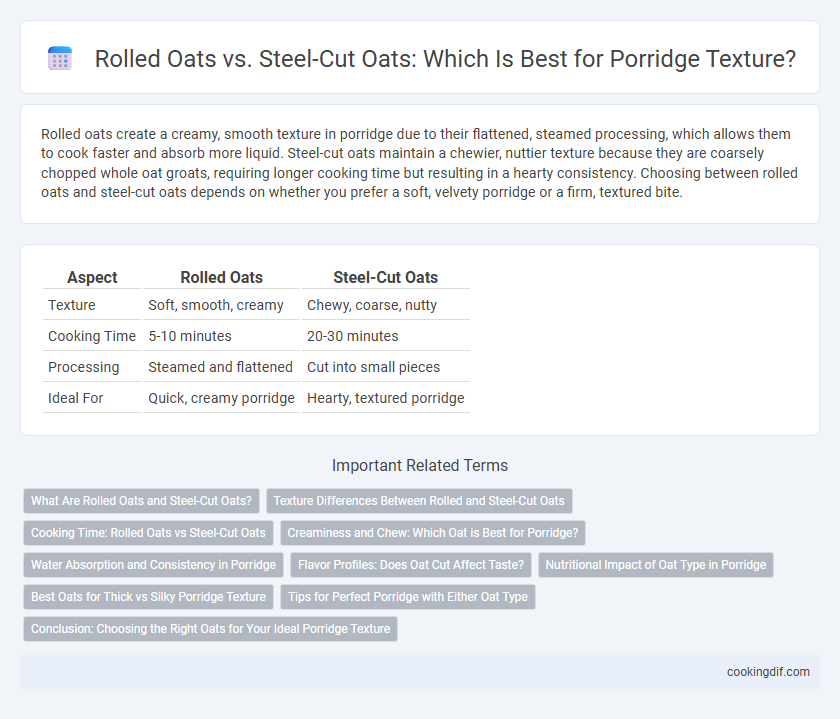Rolled oats create a creamy, smooth texture in porridge due to their flattened, steamed processing, which allows them to cook faster and absorb more liquid. Steel-cut oats maintain a chewier, nuttier texture because they are coarsely chopped whole oat groats, requiring longer cooking time but resulting in a hearty consistency. Choosing between rolled oats and steel-cut oats depends on whether you prefer a soft, velvety porridge or a firm, textured bite.
Table of Comparison
| Aspect | Rolled Oats | Steel-Cut Oats |
|---|---|---|
| Texture | Soft, smooth, creamy | Chewy, coarse, nutty |
| Cooking Time | 5-10 minutes | 20-30 minutes |
| Processing | Steamed and flattened | Cut into small pieces |
| Ideal For | Quick, creamy porridge | Hearty, textured porridge |
What Are Rolled Oats and Steel-Cut Oats?
Rolled oats are steamed and flattened oat groats that cook quickly, resulting in a smooth, creamy porridge texture. Steel-cut oats are whole oat groats chopped into coarse pieces, producing a chewier, nuttier texture when cooked. The difference in processing between rolled oats and steel-cut oats significantly influences the porridge's consistency and cooking time.
Texture Differences Between Rolled and Steel-Cut Oats
Rolled oats create a smooth, creamy texture in porridge due to being steamed and flattened, allowing them to absorb water quickly. Steel-cut oats retain a chewier, coarser consistency because they are minimally processed, maintaining their whole grain structure. These texture differences influence cooking time and mouthfeel, with rolled oats producing softer porridge and steel-cut oats offering a heartier, nuttier bite.
Cooking Time: Rolled Oats vs Steel-Cut Oats
Rolled oats cook significantly faster than steel-cut oats, typically requiring about 5 minutes, making them ideal for quick porridge preparation. Steel-cut oats need 20 to 30 minutes to achieve their chewy, nutty texture, offering a heartier and more substantial porridge. Choosing between the two depends on desired texture and available cooking time, with rolled oats providing a smoother consistency and steel-cut oats delivering a firmer bite.
Creaminess and Chew: Which Oat is Best for Porridge?
Rolled oats produce a creamier porridge due to their flattened shape, which allows them to absorb more water and cook faster, resulting in a smooth texture ideal for a comforting breakfast. Steel-cut oats offer a chewier and nuttier texture because they are simply chopped whole oat groats, requiring longer cooking times that maintain a firmer bite. For the creamiest porridge, rolled oats are best, while steel-cut oats are preferred for those who enjoy a hearty, chewy texture.
Water Absorption and Consistency in Porridge
Rolled oats absorb water more quickly due to their flattened shape, resulting in a creamier and smoother porridge texture. Steel-cut oats, being coarser and less processed, absorb water more slowly and retain a chewier, nuttier consistency. Water absorption rate directly impacts porridge consistency, with rolled oats creating a thick, velvety texture while steel-cut oats yield a hearty, coarse porridge.
Flavor Profiles: Does Oat Cut Affect Taste?
Rolled oats produce a creamy, smooth texture with a mild, slightly nutty flavor that allows added ingredients to shine in porridge. Steel-cut oats offer a chewier, heartier bite and a robust, slightly nutty taste that enhances the porridge's earthiness. The oat cut significantly influences the flavor profile by altering texture and subtle nutty notes, impacting the overall sensory experience of porridge.
Nutritional Impact of Oat Type in Porridge
Rolled oats and steel-cut oats differ significantly in texture, with rolled oats offering a smoother, creamier porridge and steel-cut oats providing a chewier, coarser consistency. Nutritionally, steel-cut oats retain more fiber and protein due to their less processed form, enhancing satiety and promoting better blood sugar control. Both oat types contain similar amounts of essential nutrients like iron, magnesium, and B vitamins, but the lower glycemic index of steel-cut oats makes them more beneficial for sustained energy release.
Best Oats for Thick vs Silky Porridge Texture
Rolled oats provide a softer, creamier texture ideal for silky porridge, as their flattened flakes absorb water quickly and cook faster. Steel-cut oats create a thicker, chewier porridge with a hearty texture due to their coarse, chopped grain structure that holds shape during cooking. Choosing between rolled and steel-cut oats depends on preferred porridge consistency--silky smooth versus robustly thick.
Tips for Perfect Porridge with Either Oat Type
Rolled oats create a creamy and smooth porridge texture, while steel-cut oats offer a chewier and nuttier consistency. For perfect porridge with rolled oats, cook them gently with a 2:1 liquid-to-oats ratio, stirring occasionally to avoid lumps. When using steel-cut oats, simmer slowly in water or milk for 20-30 minutes, stirring frequently, and adjust liquid as needed for preferred thickness.
Conclusion: Choosing the Right Oats for Your Ideal Porridge Texture
Rolled oats create a smoother, creamier porridge with a softer texture due to their flattened shape and quicker cooking time, making them ideal for a comforting, easily digestible breakfast. Steel-cut oats retain a chewier, nuttier consistency because they are less processed and take longer to cook, providing a hearty and textured porridge experience. Selecting between rolled and steel-cut oats depends on whether you prefer a creamy softness or a robust, chewy bite in your porridge.
Rolled oats vs steel-cut oats for porridge texture Infographic

 cookingdif.com
cookingdif.com